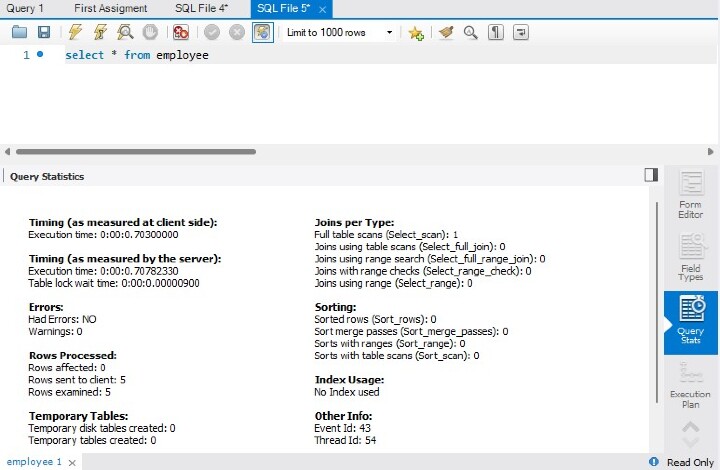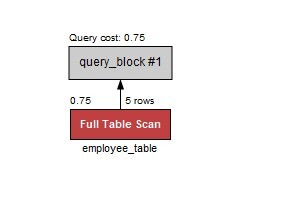Query statistics in MySQL
Important statistics collected for the executed query, including time, temporary tables, indexes, joins, etc., are collected in the "Query Statistics SQL Editor Results" tab (see the following two images).
Require
Enable queries and collect performance schema statistics.
performance_schema Statement detection enabled.
SQL Editor: Query Statistics

Visual Interpretation Plan
The Visual Explanation feature creates and presents a visual description of a MySQL EXPLAIN statement by leveraging additional data contained in the enhanced JSON format. All EXPLAIN formats, including standard format, raw extended JSON, and visual query plans, can be used to execute queries in MySQL Workbench.
Intuitive demonstration of use
Execute the query in the SQL Editor and select Execution Procedure from the query results menu to receive a visual description of the execution plan. In addition to the default visual explain view, the execution plan also contains a tabular explain view, similar to what you see when you run EXPLAIN in the MySQL client. For more information about how MySQL executes statements, see Optimizing Queries Using EXPLAIN.
Visual explanation convention
Visual explanation diagrams should be read from bottom to top, left to right. An overview of the graphical, textual, and informational conventions used to represent the various elements of a visual interpretation plan is given in the diagram example below. For more details, see -
Graphics Standard
Information and text conventions
Visual explanation of the first graph The graph provides a visual description of the following query.
select * FROM employee_table
Visual explanation example

Graphic convention
Standard box: table
Rounded corner box: GROUP and SORT operations
Frame Box: Subquery
Diamond: Connection
Text and information conventions
Standard text below box: Table (or alias) name
Bold text below box: Key/index used
The number in the upper right corner of the box: the number of rows used in the filtered table
The number in the upper left corner of the box: the relative cost of accessing the table (requires MySQL 5.7 or higher)
The number on the right side of the nested loop (or hash join) diamond: the number of rows generated by the JOIN
Number above diamond: relative cost of JOIN (requires MySQL 5.7 or higher)
The following table shows the relevant colors and descriptions used in visual interpretation diagrams. For more information about cost estimates, see Optimizer Cost Model.
Visual explanation chart information
system name |
color |
Text on visualization chart |
Tooltip related information |
|---|---|---|---|
system |
blue |
Single line: system constant |
The cost is very low |
constant |
blue |
Single line: constant |
The cost is very low |
EQ_REF |
green |
Unique key lookup |
Low Cost - The optimizer is able to find an index that can be used to retrieve the required records. It's fast because the index search points directly to the page containing all rows of data |
refer to |
green |
Non-unique key lookup |
Low-Medium -- Low if there are fewer matching rows; higher as the number of rows increases |
full text |
yellow |
Full text index search |
Dedicated full-text search. Low - for this specialized search requirement |
REF_OR_NULL |
green |
Search by key to get NULL value |
Low-medium - if the number of matched rows is small; higher as the number of rows increases |
INDEX_MERGE |
green |
Index merge |
Medium - Looking for better index choices in queries to improve performance |
UNIQUE_SUBQUERY |
orange color |
Unique key lookup in subquery table |
Low -- for efficient subquery processing |
INDEX_SUBQUERY |
orange color |
Non-unique key lookup in subquery table |
Low -- for efficient subquery processing |
scope |
orange color |
Index range scan |
Medium -- Partial index scan |
index |
red |
Full index scan |
High - especially for large indexes |
all |
red |
Full table scan |
Very High - Very high cost for large tables, but less impact for small tables. No free index is found for the table, forcing the optimizer to search every row. It may also mean that the search is too broad and the index will be useless. |
unknown |
black |
unknown |
Note: This is the default value in case a match cannot be determined |
in conclusion
In this article, we learned how to get query statistics in MySQL Workbench and what different characteristics it has at the same time.
The above is the detailed content of Query statistics in MySQL. For more information, please follow other related articles on the PHP Chinese website!

Hot AI Tools

Undresser.AI Undress
AI-powered app for creating realistic nude photos

AI Clothes Remover
Online AI tool for removing clothes from photos.

Undress AI Tool
Undress images for free

Clothoff.io
AI clothes remover

Video Face Swap
Swap faces in any video effortlessly with our completely free AI face swap tool!

Hot Article

Hot Tools

Notepad++7.3.1
Easy-to-use and free code editor

SublimeText3 Chinese version
Chinese version, very easy to use

Zend Studio 13.0.1
Powerful PHP integrated development environment

Dreamweaver CS6
Visual web development tools

SublimeText3 Mac version
God-level code editing software (SublimeText3)

Hot Topics
 When might a full table scan be faster than using an index in MySQL?
Apr 09, 2025 am 12:05 AM
When might a full table scan be faster than using an index in MySQL?
Apr 09, 2025 am 12:05 AM
Full table scanning may be faster in MySQL than using indexes. Specific cases include: 1) the data volume is small; 2) when the query returns a large amount of data; 3) when the index column is not highly selective; 4) when the complex query. By analyzing query plans, optimizing indexes, avoiding over-index and regularly maintaining tables, you can make the best choices in practical applications.
 Can I install mysql on Windows 7
Apr 08, 2025 pm 03:21 PM
Can I install mysql on Windows 7
Apr 08, 2025 pm 03:21 PM
Yes, MySQL can be installed on Windows 7, and although Microsoft has stopped supporting Windows 7, MySQL is still compatible with it. However, the following points should be noted during the installation process: Download the MySQL installer for Windows. Select the appropriate version of MySQL (community or enterprise). Select the appropriate installation directory and character set during the installation process. Set the root user password and keep it properly. Connect to the database for testing. Note the compatibility and security issues on Windows 7, and it is recommended to upgrade to a supported operating system.
 Explain InnoDB Full-Text Search capabilities.
Apr 02, 2025 pm 06:09 PM
Explain InnoDB Full-Text Search capabilities.
Apr 02, 2025 pm 06:09 PM
InnoDB's full-text search capabilities are very powerful, which can significantly improve database query efficiency and ability to process large amounts of text data. 1) InnoDB implements full-text search through inverted indexing, supporting basic and advanced search queries. 2) Use MATCH and AGAINST keywords to search, support Boolean mode and phrase search. 3) Optimization methods include using word segmentation technology, periodic rebuilding of indexes and adjusting cache size to improve performance and accuracy.
 Difference between clustered index and non-clustered index (secondary index) in InnoDB.
Apr 02, 2025 pm 06:25 PM
Difference between clustered index and non-clustered index (secondary index) in InnoDB.
Apr 02, 2025 pm 06:25 PM
The difference between clustered index and non-clustered index is: 1. Clustered index stores data rows in the index structure, which is suitable for querying by primary key and range. 2. The non-clustered index stores index key values and pointers to data rows, and is suitable for non-primary key column queries.
 MySQL: Simple Concepts for Easy Learning
Apr 10, 2025 am 09:29 AM
MySQL: Simple Concepts for Easy Learning
Apr 10, 2025 am 09:29 AM
MySQL is an open source relational database management system. 1) Create database and tables: Use the CREATEDATABASE and CREATETABLE commands. 2) Basic operations: INSERT, UPDATE, DELETE and SELECT. 3) Advanced operations: JOIN, subquery and transaction processing. 4) Debugging skills: Check syntax, data type and permissions. 5) Optimization suggestions: Use indexes, avoid SELECT* and use transactions.
 Can mysql and mariadb coexist
Apr 08, 2025 pm 02:27 PM
Can mysql and mariadb coexist
Apr 08, 2025 pm 02:27 PM
MySQL and MariaDB can coexist, but need to be configured with caution. The key is to allocate different port numbers and data directories to each database, and adjust parameters such as memory allocation and cache size. Connection pooling, application configuration, and version differences also need to be considered and need to be carefully tested and planned to avoid pitfalls. Running two databases simultaneously can cause performance problems in situations where resources are limited.
 The relationship between mysql user and database
Apr 08, 2025 pm 07:15 PM
The relationship between mysql user and database
Apr 08, 2025 pm 07:15 PM
In MySQL database, the relationship between the user and the database is defined by permissions and tables. The user has a username and password to access the database. Permissions are granted through the GRANT command, while the table is created by the CREATE TABLE command. To establish a relationship between a user and a database, you need to create a database, create a user, and then grant permissions.
 Explain different types of MySQL indexes (B-Tree, Hash, Full-text, Spatial).
Apr 02, 2025 pm 07:05 PM
Explain different types of MySQL indexes (B-Tree, Hash, Full-text, Spatial).
Apr 02, 2025 pm 07:05 PM
MySQL supports four index types: B-Tree, Hash, Full-text, and Spatial. 1.B-Tree index is suitable for equal value search, range query and sorting. 2. Hash index is suitable for equal value searches, but does not support range query and sorting. 3. Full-text index is used for full-text search and is suitable for processing large amounts of text data. 4. Spatial index is used for geospatial data query and is suitable for GIS applications.






